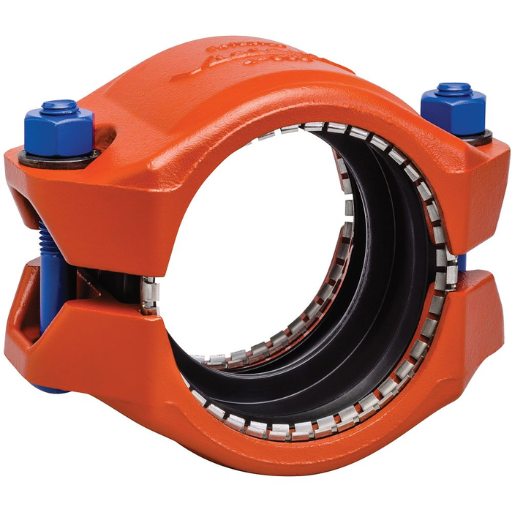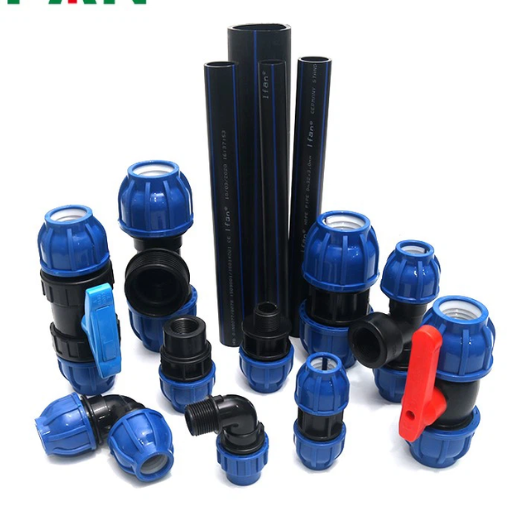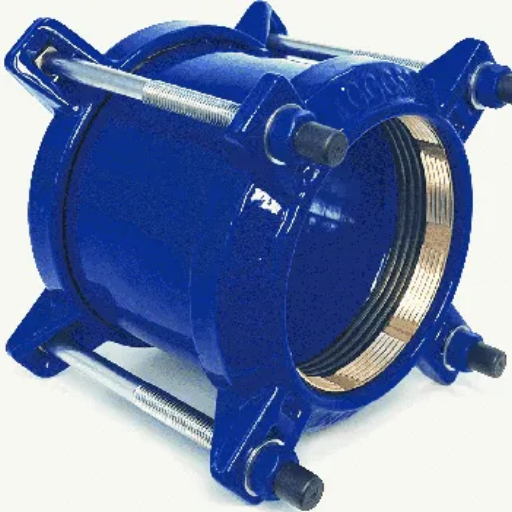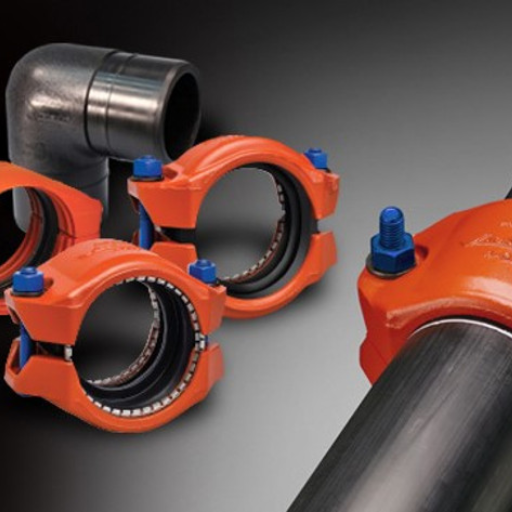The introduction of pipes made of HDPE has started a revolution in the piping industry because of the outstanding potential of these pipes in relation to durability, flexibility, and resistance to corrosion. Given that the structural necessities change and the industry calls for more robust systems, the need for high-density polyethylene (HDPE) pipe coupling becomes inevitable for quick fluid handling practices. This article will compare and contrast the prospects of the use of HDPE pipe couplings, its manufacturing technologies, and its end-users. For those involved in municipal works, industrial activities, or agricultural systems where the ergonomics and maintenance of such apparatuses are of significant long-term consideration, learning how the performance of such systems is enhanced through the use of HDPE coupling could be beneficial. Prepare to enter the world of HDPE and witness how these outstanding pipe couplings are changing business standards with new couplings for piping systems.
What is an HDPE Pipe Coupling?

When two lengths of high-density polyethylene pipes are joined together, an epoxy HDPE pipe coupling is used as the connecting element. The major requirement for such couplings should be the strength and elasticity of the pipes or Hybrid Coupling Pipe Systems/Joints, which should be ensured to be fully leakproof and robust. Thanks to modern manufacturing technologies, the performance of the elastic but sufficiently rigid structures of the High-Density Polyethylene Pipe Joint Couplers is perfect under varying temperature conditions. They are essential for the places where strong and effective fluid can be conveyed in both pressure and non-pressure systems.
Understanding HDPE and Its Benefits
I have come to appreciate the benefits of HDPE (High-Density Polyethylene) and how it changes the piping systems’ landscape. Most importantly, the high resistance of HDPE helps to increase the lifespan of the infrastructure, therefore limiting the need for repairs and replacements. Its versatility and toughness allow it to endure high stress, not to mention its flexible properties, which enable it to function under high pressure and stress. Additionally, given the high resistance of HDPE to corrosion, the material can be relied on for many years despite its usage in most dire circumstances. Due to its elasticity, which allows it to adapt to thermal changes satisfactorily, HDPE pipe coupling is ideal for fluid management in any application, from city infrastructure to construction and farming systems.
Types of HDPE Pipe Couplings Available
the types of couplings that are used with HDPE pipes, which are essential in making sure that the fluid is well managed. Butt-fusion couplings will be the first category of couplings, which are generally preferred thanks to their high strength and the ability to create a highly effective joint by heating and joining the ends of the pipes; this method is ideal for use in high-pressure systems. The second type is electrofusion couplings, in which the joining of the pipe and fitting is done using an electric coil embedded into the fitting. This provides strong and reliable connections, which are ideal for applications where it is not possible to rotate the pipes. Another option is the mechanical couplings, which are especially useful for their ease of installation and use without specialized equipment, allowing quick repairs and modifications. It’s also necessary to mention transition couplings, which provide the connection between HDPE and metal piping systems. These couplings integrate HDPE systems so that they can be used in a number of applications while providing a strong and reliable connection.
Key Features of HDPE Pipe Fittings
To begin with, durability is clearly a stronger point when it comes to HDPE since it is impermeable to a number of environmental factors like chemicals, UV rays, and the like, which guarantees longevity. Then again, flexibility is a key factor; HDPE fittings are capable of enduring ground movements or thermal expansion without the fittings ever cracking, making them usable in many environments. Providing corrosion resistance is also an advantage of HDPE fittings because, unlike metal ones, they will not rust or corrode even in aggressive environments and, therefore, will have low maintenance. Transport and installation are also easier due to their relatively low weight, allowing labor and equipment costs to be cut. Finally, low environmental impact coupled with the ability to be recycled makes HDPE an attractive alternative for any environmentally minded initiatives. In conclusion, these parameters would also help to explain why, when it comes to fluid management systems, HDPE pipe fittings are quite effective in terms of cost, reliability, and sustainability.
How to Choose the Right Fitting for Your HDPE Pipe?

Choosing the Right Fitting for Your HDPE Pipe
When you’re looking to buy a PE pipe fitting and connect the pipe, there are many factors that need to be looked at first. Start with considering the system’s new application, for instance, designing the pressure and temperature rating that the fittings should be able to withstand. Moving on, have a look at the pipe diameter and thickness to confirm that they correspond with the fitted plumbing works. Furthermore, environmental conditions have to be focused on, for example, chemicals, UV, or other exposure, in order to decide which material attributes are necessary. Other important factors include settling for compatible systems, ease of fitting the application, and the life of the application. Finally, It is recommended to use fittings from well-known manufacturers in the market who follow the standards during fittings to ensure its performance and quality. In general, concentrating on these issues helps you come up with a sound decision in relation to what the business needs and also how much the business would like to spend.
Factors to Consider: Size, SDR, and IPS
In my experience, selecting appropriate fittings is straightforward, but it is necessary to know the specific requirements of the system. First, I always determine the purpose of the system in order to estimate the level of pressure and temperature fitting that it has to withstand in order to operate properly. Practice has shown me that the diameter of the pipe and its wall thickness should also be taken into account in order to have system compatibility and integrity. Environmental considerations such as chemical and ultraviolet exposure are also important factors in selecting the most effective fittings. My concern also includes ensuring the ease of installation and integration with current systems so that there will be no operational issues. Lastly, there are some fittings I cannot do without, and a trustworthy manufacturer of fittings with industry standards is one of them, as it ensures reliability and quality. Reasoned consideration of the factors mentioned above has allowed me to implement reliable and cost-effective solutions that coordinate with the project and the client’s expectations.
Comparing HDPE with PVC and Other Materials
I consider myself a professional in the field, hence I evaluate materials such as HDPE and PVC among others to find their applicability. This is how I explain it:
- Durability: Both materials show promising durability at a percentage level, but due to UV radiation, PVC has a limited lifespan unless UV stabilized. HDPE, however, is uniquely resistant to a wide range of chemicals and impacts, hence making it ideal for use in harsher environments.
- Flexibility: PVC on its end requires rigidness especially when installed in structures that require a greater amount of support whereas HDPE being more flexible provides greater wearing aptitudes specifically for shifts or movements in the ground.
- Temperature Tolerance: The Working temperature ranges for both materials are vastly different allowing them each to be used in places with temperatures based on their characteristics but still PVC works better under a controlled moderate temperature.
- Cost: On average PVC is cheaper which works for projects with confinements on budgets. Whereas the long term savings and low maintenance required for HDPE makes it a costlier yet a better option.
- Installation: HDPE due to its flexibility is easier to install as it requires fewer insertions specially in difficult terrains. PVC on the other hand requires more fittings as well as requires alignment closely.
Taking these aspects into consideration, I advocate using HDPE for projects requiring flexibility and environmental resistance, while PVC could be considered whenever practicality in terms of price and rigidity is needed. I would still point out that all materials have their strong points and making the choice is determined by the nature of the application in a particular case.
How is Installation of HDPE Couplings Performed?

Though installing HDPE couplings poses no major setback, the process needs to be approached carefully to ensure that there are no issues concerning the efficiency and integrity of the final product. Below are the steps and factors that need to be considered:
- Site Preparation: The condition of the site should be such that it is devoid of any resources as this increases the chances of contamination during installation. Therefore, it is important to start by cleaning the environment.
- Pipe Preparation: There is a need to ensure that the pipes are cut to the appropriate lengths, and at any joint roughs are put down to help with nominal stress and tighten the bonds. This is because rough edges anywhere especially at the final joint increases the chances of the joint breaking or leaking.
- Cleaning: Make use of a properly cleaned cloth or rag and wipe the surface of the entailed pipes as well as the areas that have been couplered, as these parts designates interlocking surfaces. Any contaminants such as moisture on the surface binds firmly onto the surface wrecking the chances of the surface sealing well.
- Alignment: Take note of both ends of the pipes, which will be required to be joined. These ends require consideration as they are to be fitted within coupling, this assures the proper functioning of the joined pipes at even pressure.
- Fitting the Coupling: Take first the HDPE coupling and slip it over the pipe. Make sure that it sits well on the half end of the pipe and then go further by placing the joint pipe end into required position and slip it over the coupling.
- Pressure Application: Depending on the coupler being used, apply a consistent amount of pressure. Plus, some couplings may require tightening with a certain tool or by hand in order for the connection to be firm as required.
- Inspection: OFinally, it is necessary to check the joint for any space or depressions that might cause disturbance in sealing. This is very vital as it helps in securing that there will be no leakages at the joint and guarantees the strengthening of the attachment.
- Testing: A pressure test should be carried out to confirm that the connection can withstand high pressures without leaking. This step confirms that the installation was done properly and that the coupling works as required.
A proper fitting process is also the easiest way to maximise the performance and durability of pipes systems. By employing and closely-following the prescribed steps, you are guaranteed an effective and firm connection that will withstand strain from various applications.
Step-by-Step Guide to Fusion and Compression Coupling
I’d like to share my insights on the step-by-step process of using fusion and compression coupling with HDPE pipes. In my view, the level of accuracy with which work is done on each of the steps tends to alter the performance and the lifetime of the pipe connections.
To begin with, I regard the pipe ends to be jointed only after they have been cut satisfactorily. This implies that quite a level of care has to be taken to ensure the cut carries a smooth and even surface with no burrs or rough edges which may compromise the joint. Cleanliness is next on my list. Before any coupling, I make sure I clean the pipe and coupling surfaces to remove dirt or moisture and improve the seal.
So, too is the alignment of the pipes. Thus ensuring the pipes are perfectly aligned marks the stage for a relatively easy coupling. When inserting the couplings within the pipes, I have it in my mind that it must fit in tightly. Pressure is used equally during fitting and some tools are used additionally during fitting to achieve this seal especially where more complex coupling types are engaged.
When the coupling has been established, I will focus on making an inspection in detail. The inspection encompasses a close examination of the joint to make sure that there is none, either gap or space and that the joint appears as one single piece. The pressure test is the last step in my confirmation process, whereby I confirm that the joint has been made by ensuring that no water is able to get through it. Each of these steps, when conscientiously followed, aids in the provision of an efficient and durable piping system that indeed uses HDPE.
Special Tools Required for HDPE Pipe Installation
The presence of the appropriate tools when installing HDPE pipes is critical as this will guarantee that the process is seamless and the results obtained are long-lasting. Below are the specific tools that you will generally need:
- Pipe Cutters: These cutters enable special cuts on the HDPE pipes. They ensure a performant cut is made for a seamless bond to be formed on the joint area.
- Beveling Tools: The cutting edge or ends of a pipe which require melting or joining together may be maintained using a beveling tool. Such a surface preparation improves the interface that is to be joined through reducing the resistance at the interface.
- Pipe Scrapers or De-burring Tools: This is done in order to remove the outer most layer of the pipe making sure that the debris and the oxidation layer are completely removed. It is a crucial step that enables solid and leak-proof sealing of the components.
- Alignment Clamps: The correct alignment of the pipes during coupling is provided by these devices. The seamless fit and the durability of the connection depend on the alignment of the parts.
- Fusion Machines: For butt fusion or electrofusion, these machines are indispensable as they weld pipe ends together or provide the heat that enables fusion to take place. They maintain uniform heating and melding of every surface that comes into contact with the hydraulic bloc.
- Pressure Test Equipment: This is done to test the strength and the ability of the coupling to seal after it has been installed. It ensures that the installation has been correctly done and that the system is going to operate normally.
With the help of these tools, the quality of the HDPE pipe installations as well as their reliability over time can be increased.
Common Installation Challenges and Solutions
During the installation of HDPE pipes, I faced several common challenges that had the potential to compromise the system. One of them concerns pipe alignment. This is where the problem arises if my alignment is not correct at this stage, then the end result is faulty, wasting resources and time; let me illustrate this with a case once I make use of alignment clamps to ensure all of the pipes are perfectly positioned. When the time came for fusion, the pipes were not aligned, leading to the failure of the joint and costing time and resources to fix it.
Another challenge I have faced would have to do with the pipe surfaces; for example, on a project where we had to join pipes of varying diameters, scrapers could not reach some surfaces. The dire consequences of this incident were exposed when we had to pressure test the system only to find minor leaks at the joints, which, as a result of improper preparation, could have been avoided. Now a thorough pipe cleaning with scrapers would become standard in my work as such problems have not occurred since the project in question.
Moreover, the application of excessive or insufficient heat around the joint area can have adverse effects during the fusion process. A clear example would be on one occasion when I switched to a different setting on the fusion machine, and the end results weren’t what I expected. Now joint failures have decreased significantly. This task hasn’t changed since the beginning, and these experiences in particular highlight the importance of using the proper tools to complete the task.
What Are the Benefits of Using IPS HDPE in Piping Systems?

The implementation of IPS HDPE piping systems has various benefits, such as outstanding performance and adaptability, which makes them useful in many other areas. They are resistant to corrosion and chemical attack, ensuring a long life with minimum maintenance. Their fusion joints, which are leak-free, enhance the reliability and performance of the system, and the likelihood of environmental pollution due to leaks is decreased. Furthermore, the lightweight IPS HDPE pipes make transportation and installation easier, which can help reduce potential expenses. For these reasons it is evident that IPS HDPE is ideal for use in new systems, as well as the restoration of old structures.
Advantages of IPS HDPE Over Traditional Piping
IPS HDPE pipes markedly improve on the benefits of corrosion resistance and welding when compared to steel or PVC piping. First and foremost, Thanks to the lack of a protective or galvanized coating and to the actual pipe materials themselves, any possibility of corrosion is entirely eliminated, thus ensuring system integrity for years on end and this is particularly beneficial in harsh environments packed with chemicals and moisture. In addition, Even thermal contraction expansion and ground stumbling movements will not crack these pipes due to the inherent capacity of the flexibility of the pipes themselves, which, in turn, guarantees durability while minimizing the need for constant maintenance. Moreover, IPS HDPE pipes come with the added benefit of being lightweight, which makes installation and transportation miles easier, and this, in turn, leads to not only the acceleration of project timeframes but also to cost efficiency. These benefits, as highlighted, offer IPS HDPE pipes the ability to function as a direct replacement of steel or PVC piping, and most importantly, it promotes both performance and economic efficiency across many applications.
Applications and Industries Benefiting from HDPE
I can remark that HDPE pipes are very useful and are used by various industries because of their strength and economy. I would, therefore wish to outline the areas of their applicability and industries where they flourish:
- Water Supply Systems: HDPE pipes have become the most preferred materials that are used in water supply systems. This is because they do not corrode which makes them safe and suitable for use in carrying drinking water. Because of their leakproof features, the joints maintain the integrity of the water therefore making the pipes appropriate for distribution over municipal water systems.
- Agriculture: For agricultural purposes, the use of HDPE pipes for installing irrigation systems is dominant. Their flexibility and resistance to soil chemicals and UV radiation make them ideal for long-term irrigation use. Besides, their light weight makes it easy to change their configuration whenever required.
- Gas Distribution: HDPE pipes have a wide range of applications, though to a lesser extent when it comes to distributing natural gas. They do not allow the penetration of water or gas and Joints are excellent in sealing of natural gas distribution lines.
- Wastewater and Sewage Systems: HDPE pipes have better chances of impressively doing well on waste water and sewer applications as they do not get affected by a corrosive environment or deteriorating chemicals. The ability to withstand deterioration helps maintain the structural form of parts that are incorporated in waste water.
- Mining: In the mining sector, slurry pipelines where pipe transportation is a norm are. Abrasive materials are commonplace in slurry pipelines, and HDPE’s abrasion resistance increases the service life of such pipes significantly.
- Telecommunications: The shielding of telecommunication cables in HDPE ducts protects them from the risk of being damaged due to environmental effects. They have flexible walls thus permitting complicated routing of the cables without the chances of cracking.
The parameters pertaining to corrosion resistance, adaptability, and being lightweight are the factors that make HDPE pipes preferred in different sectors, or for such applications as modeling.
How HDPE Pipe Couplings Enhance System Efficiency
- Improved Leak Prevention: With its superior sealing capabilities, HDPE pipe couplings decrease the chances of any leakages. These leak proof joints guarantee the system’s integrity over time thus reducing the time and money for maintenance and providing effective utilization of resources.
- Easy Installation and Maintenance: The coupling systems self restrain hence ease of use is markedly increased. Less time and limited equipment is used for installation since less components and lesser amount of supporting structures are needed. Due to the modular nature of the couplings, maintenance procedures are less cumbersome and thus result in efficiency in operations over a long period of time.
- Enhanced Durability: Couplings with heavy designs add strength to the point of connection of the HDPE piping systems. These couplings are made from high density polyethylene materials which are impervious to corrosion or wearing from the environment hence the piping can be used under harsh conditions without affecting their performance.
- Flexibility in System Design: Even when the original system’s design is altered, the HDPE pipe couplings do not obstruct the ability of the system to be adapted or expanded. This aspect of HDPE pipe couplings is very necessary for industries that know they will expand or develop new technology as it allows them to incorporate new technologies without having to rip the systems completely apart.
- Cost-Efficiency: Because the material is strong and durable, there will be little need for repairs and replacements, which will ultimately bring down the lifecycle costs of the HDPE pipe couplings. Time lost and maintenance required can be easily recovered by the initial outlay for high quality couplings.
In general, HDPE pipe couplings increase system effectiveness by improving reliability, decreasing costs, and speeding up installation, thus becoming an integral part of contemporary piping systems.
Where to Shop by Brand and Category for HDPE Pipe Couplings?

In cutting-edge projects that require high-density polyethylene pipes, however, it turns out that many manufacturers do not have the expertise needed to live the quality of this kind of infrastructure. In this regard, it is generally preferable to choose trusted brand names like Victaulic or GF Piping Systems, as even within the range of such manufacturers’ products, there are items known to assist clients best in the field. Certain suppliers also manufacture high-pressure pipe couplings that are stronger and able to weather harsh conditions, including marine-based applications, and these could be sought best when specified under that title category. As an industry player for quite some time, I also frequent online marketplaces and bidding sites such as McMaster-Carr and Grainger, as such platforms allow me to explore a wide selection of items at attractive prices while comparing quality as stated by customer testimonials with detailed specifications.
Top Brands Offering HDPE Couplings
- Victaulic
-
- Overview: Been able to expand diverse hand-in-hand coupling technology, a global piping systems leader, Victaulic is simply the best
- Key Features: There is a whole range of couplings that prohibit welding and economical time resources for production processes.
- Applications: Used vastly across water and sewerage systems, mundane construction, and industrial works.
- Overview: At the beginning of this field and the field as it is now, GF Piping Systems was a very high-level provider of pipes and fittings.
- Key Features: Suitable for all plumbing applications, including residential and industrial ones.
- Applications: Water treatment, chemical processing, and petrochemical works are the most common uses.
- Overview: Solutions offered include a full assortment of HDPE couplers as well as high performances thermoplastics which is ISCO Industries specialty.
- Key Features: They provide tailored solutions that ensure maximum efficiency and safety with piping systems for any kind of project.
- Applications: Most common in construction works, however, fitting in mining and geothermal systems as well.
- Overview: Past promising arguments leading to them being firms with both strength and zeal in the piping industry, AVK is a stubborn innovator and ecological funeral.
- Key Features: Extremely lower range of costs including a range of materials throughout all regions ensuring their plumbing systems are economical to maintain.
- Applications: They deal across a multitude of networks including but not limited to water systems, treatment centrals of sewage, alongside gas couplings.
- Website: AVK ValvesIn general, the leading brands provide dependable and cutting-edge solutions for both standard and customHDPE pipe couplings which guarantee leak-free piping systems in diverse industries.
Choosing the Right Category for Your Needs
Keen marketing in HDPE Pipe Couplings would see success as it is an important aspect of any project. In that instance, it is important to look at the requirements of your application. For durability in harsh conditions, lasting ability is what one might seek, and GF Piping Systems is a great option. Alternatively, there are instances where specific projects might require additional fittings to ensure efficiency and safety in the processes, such parameters can be really important in delicate sectors like construction or geothermal systems and there ISCO Industries can help one out with custom solutions. In instances where people want to minimize operational costs while being eco-friendly, they might use AVK. Therefore, each one of them is capable as all of them cater to different sectors such as industrial, residential, or commercial applications. Any suggestion that could further self-help would be trying to find and analyze all the requirements of your project and relating that with the provided solution that these big brands offer.
How to Contact Us for More Information

For more information on HDPE pipe couplings, including how to make the proper choice for your application, please contact us using the following channels:
- Email: Reach out to our experts at [email protected] for personalized assistance and detailed information.
- Phone: Call us at 1-800-555-PIPE (7473) for immediate support. Our lines are open Monday to Friday, 8 AM to 6 PM.
- Live Chat: Visit our website at www.pipingexperts.com to chat with our representatives in real-time and get quick answers to your questions.
- Office Visit: We welcome you to our headquarters at 1234 Industrial Park Drive, Suite 100, Metropolis, to speak with our specialists in person. Please schedule an appointment in advance.
We possess considerable in-house subject matter understanding of such projects and would go all the way in ensuring that you receive the support and guidance necessary for its success. Contact us today to discuss the best solutions for you that we can develop.
Reference
- HDPE Pipe ASTM Standards Guide: 16 Common Standards – This guide covers ASTM standards for HDPE materials, pipes, and fittings.
- High-Density Polyethylene (HDPE) Pipe and Fittings Specifications – Specifications for HDPE pipe and fittings, including requirements for various components.
- Specifications and Standards: Production of PE & HDPE Pipe – Information on industry specifications and standards for HDPE pipes.
- Guide to HDPE Pipe Standards: Selection and Applications – An exploration of various HDPE pipe standards and their applications.
Frequently Asked Questions (FAQs)
Q: What is HDPE pipe coupling?
A: HDPE pipe coupling refers to the process and components used to join two sections of high-density polyethylene (HDPE) pipes, providing a robust and leak-proof connection. This typically involves components like couplers and fittings specifically designed for HDPE applications.
Q: How do I achieve a secure connection using a coupling for HDPE pipes?
A: To ensure a secure connection when joining HDPE pipes, it is important to use industry-standard couplers that provide visual confirmation of the pipe within the coupler. This method ensures that the pipes are properly aligned and sealed for an air and water-tight fit.
Q: What are the advantages of using a self-locking ring in HDPE pipe fittings?
A: Self-locking rings in HDPE pipe fittings offer a secure and reliable connection. They provide easy installation, often requiring only one person, and ensure that the pipes remain firmly in place, reducing the risk of disconnection or leaks.
Q: Are there specific fittings designed for certain pressure ratings like sdr 11 or sdr 17?
A: Yes, fittings for HDPE pipes are designed to meet or exceed specific pressure ratings such as sdr 11 or sdr 17. These ratings correspond to the pipe’s thickness and pressure capacity, ensuring the system solution for HDPE pipe applications can handle the required load.
Q: Can HDPE pipe couplings be used for both air and water applications?
A: Yes, HDPE pipe couplings are designed to be air and water-tight, making them suitable for a wide range of applications involving both air and water. This versatility makes them a popular choice in various industries.
Q: What is the significance of the industry’s first-ever installation-ready™ plain end HDPE pipe?
A: The industry’s first-ever installation-ready™ plain end HDPE pipe offers significant advantages in terms of ease of installation and reliability. These pipes are designed to simplify the coupling process, providing a more efficient and error-free installation.
Q: How does the use of high-strength molded plastic improve HDPE pipe fittings?
A: High-strength molded plastic used in HDPE pipe fittings ensures durability and resilience, even under high pressure or adverse environmental conditions. This material choice contributes to the long lifespan and reliability of HDPE piping systems.
Q: What is the role of a self-locking ring in HDPE pipe couplers?
A: A self-locking ring in HDPE pipe couplers serves to automatically secure the pipe once inserted, providing a reliable seal without the need for additional tools or adjustments. This feature facilitates faster installation and ensures the coupling remains tight and leak-proof.
Q: Why is visual confirmation of the pipe within the coupler important?
A: Visual confirmation of the pipe within the coupler is important to ensure that the pipe is properly seated and aligned. This verification step helps prevent leaks and ensures the integrity of the connection, contributing to the overall reliability of the pipeline system.





